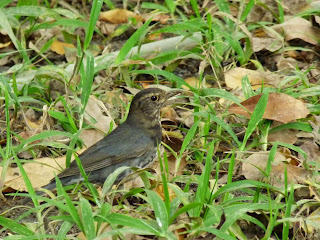One day trip to Mount Ba Vi last Sunday (26th December).
In winter, this mountain can be very foggy and birding impossible. Sunday, the weather was nice, cold for sure but no mist, and the 3 famous peaks were perfectly visible as the photo shows (foreground : Đồng Mô lake):

Highlights : 2 Tristram's Buntings, 1 male Fujian Niltava and 1 Chestnut Bulbul (hard to believe I know, but good views...)
- Thrushes : 1 Black-breasted, some Grey-backed and Scaly
- 1 Verditer Flycatcher- 1 Stripe-Tit Babbler
- 1 Oriental Turtle Dove- Flowerpeckers : 1 Scarlet-backed and 2 Fire-breasted feeding on the same fruiting tree
- very showy Orange-bellied Leafbirds, male singing and female- 1 Chestnut-flanked White-eye in a flock of Japanese ones.
- Sunbirds : 2 Crimson, 1 Fork-tailed- some Orange-flanked Bush Robins
- 1 Green Magpie sp Tristram's Bunting. I flushed 2 birds, non identified. One of them, more curious, reappeared in the thickets in which they had just disappeared, and observed me during long et nice seconds.
Tristram's Bunting. I flushed 2 birds, non identified. One of them, more curious, reappeared in the thickets in which they had just disappeared, and observed me during long et nice seconds. Fire-breasted Flowerpecker male
Fire-breasted Flowerpecker male Fire-breasted Flowerpecker female
Fire-breasted Flowerpecker female Gorgeous Crimson Sunbird male
Gorgeous Crimson Sunbird male Blue-throated Barbet. I saw this bird 500m after the cactus garden, so at low altitude (300m). Each time I go to Ba Vi, I stop at this place which offer panoramic view on the valley and I have generally a contact with this species, moving in a degraded open forest. I don't understand why this bird which don't seems to have narrow habitat requirements (I mean good forest) is so rarely spotted elsewhere.
Blue-throated Barbet. I saw this bird 500m after the cactus garden, so at low altitude (300m). Each time I go to Ba Vi, I stop at this place which offer panoramic view on the valley and I have generally a contact with this species, moving in a degraded open forest. I don't understand why this bird which don't seems to have narrow habitat requirements (I mean good forest) is so rarely spotted elsewhere.On the way back to Hanoi, I came across a flock of 20-30 Grey-capped Greenfinches at Đồng Mô lake, along the dyke (the northest one), feeding over grasslands grazed by cattle and perching sometimes on eucalyptus trees. Difficult to approach.

 A nice birding trip with 2 lifers in the pocket (the Greenfinch and the Bunting), exactly one year after I began to interest myself in the vietnamese avifauna and twitched my very first local bird, it was a Robin Magpie...
A nice birding trip with 2 lifers in the pocket (the Greenfinch and the Bunting), exactly one year after I began to interest myself in the vietnamese avifauna and twitched my very first local bird, it was a Robin Magpie...Merry Christmas and Happy New Year to everyone !














































